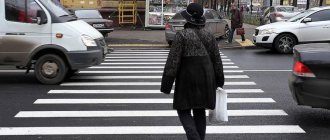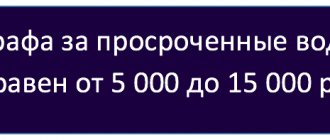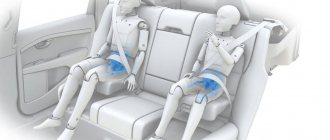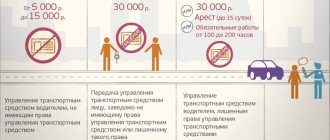When driving your own car on city roads or on a highway, a motorist must remember to comply with traffic rules. Of course, no one is immune from an accidental offense while sitting behind the wheel, however, some drivers, while driving a vehicle, commit a serious offense by crossing a continuous marking strip.
According to the Traffic Regulations, regardless of whether the roadway is divided by one or two marking lines, it is prohibited to run over or cross these stripes. Therefore, if a car owner who has committed such an offense, while performing a sharp maneuver, overtaking or turning around, is recorded by a video camera, or catches the eye of a traffic police officer, he will be charged with a penalty for hitting a dividing marking in accordance with the Code of Administrative Offenses of the Russian Federation.
Types of solid lines
A continuous marking strip of the following types is applied to the road surface:
- Single. This strip distributes the flow of cars moving in opposite directions.
- Double. The functions of this strip are the same as a single marking, but its difference is that it is applied when the number of vehicle lanes in each direction is more than two.
- Constant. This stripe is painted with white or yellow paint.
- Temporary. An orange stripe that is painted only during the period of road repairs.
Regardless of the type of continuous strip that the car owner crosses, he may be subject to administrative liability. Continuous markings can be indicated both within the city limits and outside the city. It warns the motorist about the impossibility of crossing it or overtaking a vehicle driving in front of it.
Violation caused by negligence of road services
In some situations, the driver’s behavior on the road depends on the correct performance of their duties by special service employees.
In a specific situation - from applying road markings. This process is regulated by strict GOSTs, if there are prerequisites, then there is a chance to win a legal dispute with representatives of the traffic police due to incorrect markings. Broken horizontal markings serve as a warning that the line will soon become continuous and overtaking will be prohibited. Based on the rules, a specific sign must be placed in front of the solid ones - a broken line, the strokes of which are three times longer than the space between them.
If there is nothing like this on the road surface, then this is a clear violation of GOST standards. And then the crime remains in question, since the fault lies not only with the driver. But provided the markings are according to all standards, the owner of the vehicle is solely to blame.
That is, drawing solid lines is prohibited immediately after standard broken lines, since the driver does not have time to navigate the situation on the road. If the road services are negligent, you can challenge the actions of the traffic police on the basis of the inability to react in a timely manner.
Fines for crossing a continuous road
Crossing continuous markings is considered a gross unlawful act, since such an event is dangerous and can cause an accident.
As a rule, crossing a continuous strip involves driving into the oncoming direction. For the implementation of this illegal event, two types of punishment are provided:
- Financial penalty equal to 5,000 rubles.
- Withdrawal of a driving license for a period of 4 months or more. The time of deprivation increases if a similar violation is repeated and can reach up to 1 year (Parts 4, 5, Article 12.15 of the Code of Administrative Offenses of the Russian Federation).
According to the laws of the Russian Federation, a traffic police inspector does not have the right to confiscate a driver’s license in case of a traffic violation. The driver is obliged to submit the driver's license on his own, subject to the relevant decision of the judicial authority.
The fourth part of Article 12.15 of the Code of Administrative Offenses of the Russian Federation regulates that if a motorist crosses a continuous marking for the first time, then he is subject to a financial penalty. Confiscation of driving license in such situations is rarely carried out, mainly if the offense led to an accident.
You can watch a video about the punishment a driver faces for crossing a solid line.
( Video : “You’re on air!” Intersection of a double solid line in Kurgan)
Overtaking
Overtaking is not a traffic violation, but such a maneuver is a complex action that creates a certain danger.
Most often, a driver is penalized not for overtaking a car in front, but for hitting a continuous marking. If there is a continuous line on a road section, overtaking or crossing it is prohibited. The exception is the yellow continuous stripe, i.e. a temporarily marked strip, which is most often applied if the road is being repaired or an accident has occurred, etc.
In the future, it is assumed that motorists will not be fined for such traffic violations, but will be immediately deprived of their driving license. Officials believe that tougher penalties could discourage motorists from aggressive driving, which will reduce the number of accidents.
Avoiding traffic jams (obstacles)
The current traffic rules do not define the term detour, so in this case you can be guided by the standards of Article 12.15 of the Code of Administrative Offenses of the Russian Federation, where in part 3, as well as in paragraphs 9.2 and 15.3 of the traffic rules, it is indicated that a detour is a certain action related to the intersection of continuous markings, if it is not possible to continue moving along the initial lane, that is, if the vehicle changes its lane due to the presence of an obstacle ahead, then its action is considered as a detour.
In all other options, i.e. If a vehicle is moving in the oncoming lane, such an action is regarded as overtaking.
There are 3 options that do not allow detour:
- Detour into oncoming traffic on a road with 4 lanes or more traffic.
- Detour on a 3-lane road surface with access to the far left traffic.
- Detour with oncoming traffic in front of the railway rails.
In all other cases, detour is permitted. These options include:
- Detour without crossing continuous markings.
- A detour into oncoming traffic on a 2-lane road marking or into the central lane on a 3-lane road surface, not in front of the railway rails.
For failure to comply with detour rules, the motorist is subject to a financial penalty of 1,000 to 1,500 rubles.
Driving in the oncoming lane before turning left
A travel lane is an element of the road surface used for the movement of wheeled vehicles, with painted or unpainted markings with the required width to ensure the movement of vehicles in one row.
Traffic regulations regulate when driving into oncoming traffic is prohibited. In this version, this is reflected in clause 8.6, clause 9.2, 9.3 of the Rules.
If a motorist makes a left turn maneuver, running into two or one continuous stripes, and before making the turn “jumps out” towards the moving stream, then he is liable on the basis of Part 3 of Art. 12.15 of the Code of Administrative Offenses of the Russian Federation, expressed by a penalty equal to 1000 to 1500 rubles and even confiscation of the driving license.
Random intersection of solid
Accidental intersection of continuous markings can include the collision of a car wheel with a marking when turning in a large vehicle. This option also applies to unlawful action regulated by Art. 12.16.1, with a penalty equal to 500 rubles.
Rotate and pivot through a solid line
When turning or turning around through continuous markings, the motorist is subject to a penalty equal to 1,000 to 15,000 rubles (Part 2, Article 12.16).
Most often, such an offense is committed when leaving a parking lot onto a general-purpose road surface. The car owner immediately makes a left turn, instead of turning right, driving to the dotted markings and making a U-turn there.
What actions should be taken if the broken line on the road ends?
If the car owner has already begun to overtake a car through intermittent markings, but while driving in the opposite lane he sees that he is approaching a continuous marking, then the best thing to do is to reduce the speed of the car, stop overtaking the vehicle ahead and return to your lane.
Now let's figure out at what point you need to stop driving around cars and return to your lane. Road markings are applied sequentially. First there are short intermittent strokes, then they are replaced by longer ones, and after a certain segment a continuous stroke without spaces begins.
Thus, if you see that you are approaching long intermittent strokes and your car has not yet completely overtaken the one in front, then reduce your speed.
Of course, in practice the driver has a choice:
- Do not ignore the rules and stop overtaking the car.
- Neglect the rules and overtake a car while driving on a continuous road, risking your driver's license.
However, circumstances on the road are different and the decision made by the driver can also be “one thing in one situation, and another in another.”
Example. You notice that you are approaching continuous markings and do not have time to overtake the vehicle. At the same time, the car that was driving behind you started overtaking you, and it was already approaching you from behind. If you slow down or stop altogether, a collision will occur, since the second car owner cannot foresee such a maneuver in advance. In such a situation, it is better to overtake until the end through the solid road, despite disregarding the rule. Yes, because of this you can temporarily lose your license or spend money on paying a fine, but the consequences of an accident can be much worse.
We also note that if the road you are driving on is narrow and you cannot find a good place to overtake for a long period of time, then it is better to choose it and stop driving for 1 - 2 minutes. During this time, you will catch your breath, and besides, the car in front of you will have already gone a sufficient distance and you will not cross paths with it any further.
Table of penalties for crossing a solid line and a double solid line
The law makes no difference in the punishment for hitting a single or double marking strip. The Code of Administrative Offenses of the Russian Federation regulates the following liability for hitting continuous markings:
- When driving into oncoming traffic, a financial penalty of 5,000 rubles or confiscation of driving license for 4 months is imposed (Part 4 of Article 12.15.).
- A U-turn or a left turn while ignoring continuous marking stripes involves a fine of 1,000 to 1,500 rubles (Part 2 of Article 12.16.).
- Repeating the offense while driving into oncoming traffic requires the confiscation of your driving license for 1 year. If such an unlawful action is recorded by a video camera, a financial penalty of 5,000 rubles is imposed (Part 5 of Article 12.15).
In addition, the type of liability can be reduced or tightened:
- If the fine is repaid before 20 days, the fine is offered a 50% discount.
- If the motorist does not pay off the collection debt within the time established by law (60 days), the punishment may be doubled, or he will be sentenced to arrest for 15 days, or assigned correctional labor for up to 200 hours.
Below is a table of penalties for crossing the designated continuous line.
Rotate and pivot through a solid line
When driving a vehicle, situations may occur when the driver is forced to cross continuous markings in order to avoid an accident or a collision with a pedestrian.
In this option, unlawful measures are considered as unlawful actions of other participants on the road, and not of the motorist who ran into a continuous marking strip. The inspector who arrived in such cases is obliged to understand the situation and if the car owner is not guilty, then no punishment is imposed on him.
Moreover, if a pedestrian was injured and, in order to provide more immediate assistance, the motorist turned around, crossing a continuous strip in order to quickly deliver the victim to the hospital, then in this case the motorist will not be held responsible for such actions. Also, in this case, the car owner will not be held responsible for leaving the scene of the accident.
Helpful advice
If you overtook and a traffic police officer stopped you for this, then in the process of drawing up a protocol on an administrative offense, do not stand idle. Start taking pictures of everything around you, at least with your smartphone. Even if your camera doesn't take very good pictures, you don't have to give up on capturing what's happening. If the state of the markings is already poor and it is difficult to decipher, then having photographs of it can achieve a lot in court. To prevent the judge from perceiving you as a person evading responsibility, it is important that the route, markings, markings and location of your car are included in the photograph or video.
It is important to reflect your disagreement or other interpretation of the problem in the protocol in writing in your own hand. Be sure to make sure that it is compiled as correctly as possible and the information in it is true. Take all possible measures so that the judge receives exculpatory arguments in your favor if the traffic police officer does not want to understand the situation.
Is it possible to lose your license for crossing a solid line?
Crossing a continuously marked line is one of the most common illegal events.
Liability for such an illegal event hits the car owner’s wallet quite painfully, up to the loss of the right to drive the vehicle. At the same time, it should be noted that it is impossible to deprive a driving license with only a video camera image, since video cameras only record an illegal action committed by a motorist, without taking into account the current situation on the road section. The maximum recovery possible in this option is 5,000 rubles.
However, if such an illegal maneuver is recorded by a traffic police officer, then in this case, the choice of punishment will belong to him, and, depending on the reason for crossing the continuous strip, the car owner may lose his driving license from 4 months to six months.
Controversial situations
Sometimes, on the road, a dispute may break out with a traffic inspector about the fact that the car owner crossed a continuous line under forced circumstances.
And if the motorist is able to prove that he is right, then there will be no punishment. Possible controversial circumstances when crossing continuous markings:
- It is impossible to bypass any obstacle on the right. This could be: a cobblestone, an abandoned car, a load, a fallen tree, etc.
- If, in such cases, it is impossible to go around the obstacle on the right, then the motorist will not be held responsible for going around the obstacle on the left by crossing continuous markings.
- In this option, the driver must wait for oncoming vehicles to pass and carefully detour, driving into a continuous strip.
- If, nevertheless, the inspector determines that a detour on the right was possible, then the driver will be issued a penalty.
Note. Congestion, traffic jams, stopped cars, etc. are not considered an obstacle.
For example, if there is a huge traffic jam ahead, the front car is moving a meter per minute, you cannot go around it on the left by crossing a solid line. If the broken vehicle is located 500 meters ahead of the moving vehicle (for example, the vehicle is being evacuated), you can safely go around such an obstacle, carefully crossing the continuous strip.
Driving into oncoming traffic to prevent an accident cannot be considered an offence. In this option it is required, according to Art. 2.7 of the Code of Administrative Offenses of the Russian Federation, prove to the inspector the extreme necessity of such a maneuver, that is, there was no other way to avoid the accident.
The driver overtook the car where it was prohibited with a “No Overtaking” sign.
You cannot cross oncoming traffic where the “Overtaking is prohibited” road sign applies. Moreover, it makes no difference what type of marking is applied to the road: dotted or single.
It also happens that the applied markings contradict the road sign installed on one section of the road, or the first one is difficult to distinguish. Then you need to rely on the meaning of the road sign. This is regulated by Article 12.15, Part 4 of the Code of Administrative Offenses of the Russian Federation.
But there is an exception. In the territory covered by the traffic sign prohibiting overtaking of all types of vehicles, you can drive around non-mechanical vehicles. But if you are driving behind a slowly moving truck transporting watermelons, then you are prohibited from overtaking it. Slow-moving vehicles include only those that have the appropriate sign.
Is it possible to challenge the punishment?
A motorist has every right to appeal a fine if he believes that he has been punished unfairly. This can be done by sending a claim to the court structure. The chances of winning can be positive if:
- Unclear continuous markings if the stripe has been erased or drawn on top of the previous one. To confirm that you are right, it is advisable to show eyewitness accounts of the event, or photos and videos.
- Recording an offense on a video camera. Considering that video cameras cannot record the circumstances of the incident. In this case, you need to provide evidence of your innocence.
If the car owner does not agree with the fine received, then he needs to challenge the decision by sending an application to the court within 10 days from the date it was imposed.
In what cases is a fine collected from the driver, and in what cases will he be deprived of his driver’s license?
For crossing continuous markings, two types of administrative liability are established: a fine or confiscation of the driver’s license. Now let's take a closer look at what is used and when.
Minor offenses related to crossing markings are punishable only by a fine and there is no need to consider them in court. But when the car owner drove in the oncoming lane for at least a couple of meters, then this case will already be considered in court. But there are also exceptions.
For example, if a protocol was generated for an offense recorded using a video recording system. In such a situation, punishment in the form of a fine is applied.
The judge’s decision is also influenced by information about whether the offending driver was brought to justice. responsibility earlier. If it turns out that he was issued a lot of fines, even if he paid them all off on time, then this fact will have an extremely negative impact on him. Only fines assigned on the basis of photographs or video recordings fall under the exception. They will not affect the judge's verdict in any way.
If the driver can document that he uses the car to earn his main income, then this will be perceived as a mitigating circumstance when withdrawing his driver’s license. In addition, papers confirming that the offender has one or more dependent children will also be considered in his favor.
If the prosecutor has fully proven the driver’s guilt, then the only way to mitigate the punishment is to admit guilt and repent of what you did. If this is not done, then a second meeting will be scheduled and traffic police officers will be involved as eyewitnesses. Since the judge has no reason not to believe their testimony, it will be almost impossible to get away with just a fine in this case.











